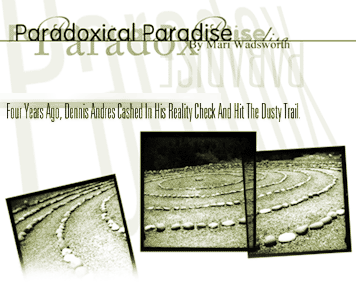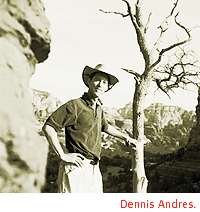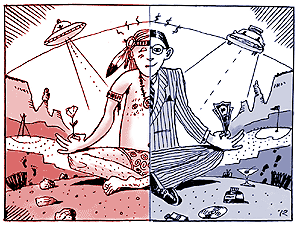
Four Years Ago, Dennis Andres Cashed In His Reality Check And Hit The Dusty Trail.
By Mari Wadsworth
YOU DON'T NEED a psychic to find spiritual tour guide Dennis
Andres; he has voice messaging. And whatever he's expecting that
day, you'll likely hear it there--directions, a cell phone number,
a time to rendezvous. You can leave your name and number for information
on tours in Sedona, the Red Rock Yoga Adventure, and swimming
with wild dolphins in Hawaii. And although the messages change
daily, they all end the same: "Remember, life is an
adventure, so have a great day!"
 You ask yourself: is this guy for real? The 33-year-old world
traveler joined the ranks of Sedona's metaphysical elite about
four years ago, after retiring from being a management and finance
consultant for DeLoitte and Touche, an international firm which
hired him in 1992 to coordinate the small-scale privatization
of several state-run businesses in the former Soviet republic.
He's also worked in Czechoslovakia, Portugal and Peru (about a
year in each place), and has command of five languages: Russian,
Spanish, Portuguese, Czech and Kazakh.
You ask yourself: is this guy for real? The 33-year-old world
traveler joined the ranks of Sedona's metaphysical elite about
four years ago, after retiring from being a management and finance
consultant for DeLoitte and Touche, an international firm which
hired him in 1992 to coordinate the small-scale privatization
of several state-run businesses in the former Soviet republic.
He's also worked in Czechoslovakia, Portugal and Peru (about a
year in each place), and has command of five languages: Russian,
Spanish, Portuguese, Czech and Kazakh.
But as owner, counselor and lead guide for Meta Adventures, his
résumé leads off with a different set of job skills:
"counselor, [spirit] channel and alternative healer helping
clients to improve their personal relationships, discover work
they love and create financial success." In addition to his
tours and workshops in and around Sedona, Andres offers "small
group spiritual adventures" to Tibet, Mount Everest (Nepal),
Machu Picchu (Peru) and Kealakekua Bay, Hawaii.
But not all on the path to becoming a spiritual adventurist is
golden. A graduate from both Georgetown and the Thunderbird academy
in Glendale, Arizona, with nearly a decade of international (and
lucrative) work experience under his belt, in 1995 Andres nonetheless
found himself back in the 'burbs, living in his parents' home
in Montvale, New Jersey. Bored, frustrated and dissatisfied, he
recalls, "I was driving them crazy."
"I was stuck in a peculiar place," he continues. "It
wasn't that I couldn't get job offers. I had plenty of offers--I'd
get an offer in Europe, and I'd say I wanted to go to Latin America.
Then I'd get an offer to go work in Latin America, for even more
money...and it looked like those were offers I should take...offers
my education prepared me for, and that my skills were leading
me up to. But it wasn't satisfying. I found that I wanted more.
I came up with the session because I couldn't figure out how to
get it."
The session he refers to is one he now offers clients, called
Finding Your Destiny! It's a 55-minute phone consultation,
and the cost (about a dollar a minute) includes a tape recording
so clients can repeat the session at will. Andres says he's "field
tested" all his theories on himself, though is vague on precisely
what he teaches or where his ideas came from. But on one point
he's unwavering: it's about following your dreams.
"You don't create dreams through logic. You create dreams
through magic. That may sound like a cliché, but the point
is (that) living your dream is not a logical process. This is
one of the reasons why it's so difficult for people to find, because
it's not logical. It's not about the things you've done.
If you've never had your dream job so far, it's pretty unlikely
that you're going to find it there in your past. If it was there,
you wouldn't have left it!"
ON THE SURFACE, Andres is about as mainstream as mainstream
gets. He stands in at about 5-foot-9 in his Nike hiking shoes,
and looks like a Boy Scout leader in unwrinkled polo shirts and
hiking shorts embroidered with his Meta Adventures logo. He's
a typical bachelor, sharing a two-bedroom apartment with second-hand
furniture and an empty refrigerator in West Sedona. He drives
a relatively new Subaru Outback wagon, and spends a fair amount
of time e-mailing his global network of friends from a laptop
computer at his kitchen table.
One of his favorite books is Richard Nelson Bolles' What Color
Is Your Parachute?, which he says he's read several times.
He enthused about the new Julia Roberts movie. He teaches tennis
and has been known to swing a golf club around if the occasion
calls for it (though he's an active opponent of the new golf course
proposed for development in Sedona's Long Canyon). He's respectable;
and in spite of the fact that he's East Coast born and bred, there's
something of the West in him. Perhaps it's the gentle cadence
and earnestness in his even voice--it sounds a bit like the elder
George Bush.
Imagine that: George Bush, telling you to close your eyes and
feel the energy of the vortex surrounding you.
In other words, this is not a scary guy. This is not a New Age
hippie. This is more likely the former president of your high-school
chapter of the Future Business Leaders of America; the Catholic
boy-next-door whose parents are still married. How did he end
up in the Way-Out West with a coffee table covered with crystals
and a psychic girlfriend who reads auras?
The epiphany came at the end of a year of volunteer work in Northern
Peru (eschewing the fancy language on his résumé,
he says humbly, "I coached basketball and worked in an orphanage"):
 "My mother and my best friend flew down. (The friend) is
actually a funny guy. He had a Lutheran father and a Jewish mother,
and went to a Catholic university and converted to Islam...so
his name is Rashad now. It used to be Carl. So anyway, he came
down (Muslims don't believe in reincarnation), and my mother came
down, and we went to Machu Picchu. It was there that I had a spiritual
awakening of sorts...this extremely potent feeling that I'd been
there before, which I could not account for. I didn't believe
in reincarnation. I didn't go there hoping to have a mystical
experience. I went there, if anything, hoping not to have one.
"My mother and my best friend flew down. (The friend) is
actually a funny guy. He had a Lutheran father and a Jewish mother,
and went to a Catholic university and converted to Islam...so
his name is Rashad now. It used to be Carl. So anyway, he came
down (Muslims don't believe in reincarnation), and my mother came
down, and we went to Machu Picchu. It was there that I had a spiritual
awakening of sorts...this extremely potent feeling that I'd been
there before, which I could not account for. I didn't believe
in reincarnation. I didn't go there hoping to have a mystical
experience. I went there, if anything, hoping not to have one.
"So it didn't answer any questions. But I hit this point
where you see the ruins on Machu Picchu--a whole city the Spaniards
never found--and you say, 'All the education I've had can not
explain how this got here.' Modern man could not build this. So
for all my schooling--all this great education and hot college
stuff--I thought, maybe there's more out there I haven't learned
yet. To me that was a spiritual moment. People sometimes think
of spiritual moments as being where you get the answer, where
you get enlightened. To me, looking back, the spiritual moment
is also when you start asking the questions."
Is he the typical Red Rock metaphysician? Ask him, and he says
he is; and he's exasperated that the magazines say otherwise.
"Every time I read an article on Sedona, it seems like they
try to find the most eccentric person possible for comment. Sedona
(is) what people choose to do. It's whether they choose to walk
their talk or to float around quoting spiritual aphorisms while
not really living them. And the people who do, chances are you're
not going to meet them, because they're not on the main drag hawking
their services."
So where are they? "People come to them." Andres, who's
up at 6 a.m. daily, spends a good portion of his off-trail time
meeting prospective clients over morning coffee and evening cocktails
at two high-end resort establishments, so he laughs good naturedly
at a reporter's question if he's one of the good guys. "I'm
hoping to be," he says. "I'm hoping to be."
"There's truth to your argument that Sedona can be a cheesy
and even disingenuous place," he allows. "I know people
are offended by charging money for spiritual or healing work,
for example. But there are two sides: people need to be willing
to look at the conflict of money and spirit inside themselves.
People get so twisted up about money they can't even use the word.
So instead of asking for 10 or 50 or 100 bucks for a healing session,
they'll ask for a 'love energy donation exchange.' Somebody just
said that to me the other day! But no one has explained to me
yet why people should not prosper materially as well as spiritually."
And on the other side: "Most of the people who run into
the disingenuous people need to look at their own shit. They're
coming to Sedona for 30 minutes, or they want answers about whether
they'll find their soul mate from a psychic who they give 15 minutes
to. Maybe they should look at whether expecting to find their
soul mate in 15 minutes is really valuable information."
ANDRES IS UNCONCERNED if people don't "get" what
he's doing. "I feel like I've failed to emphasize how much
I enjoy my life," he says. "Every morning I wake up
and I see a hot-air balloon out my bedroom window, and it reminds
me that I'm living a dream."
And if such unabashed romanticism is hard for pedestrian souls
to swallow, there's no denying its sincerity. In his three-and-a-half
years as a Sedona tour guide, Andres has led nearly 1,000 visitors
on more than 30 trails in Sedona and the Grand Canyon. For his
efforts, he says, "I'm making less than I was as a management
consultant, but there's no comparison in terms of happiness."
So these days he measures his capital gains in sunrises and sunsets,
of flora and fauna identified, and the number of people--middle-aged
couples, tourists passing through--who acknowledge they've been
changed by their experiences in the ethereal red-rock landscape.
Asked if he's trying to get rich or just trying to get by, Andres
is frank that he hopes to build a healthy business. He charges
the going rate, which is between $55 and $175 per person, with
tours ranging from two hours in a car to up to eight hours on
the trail. "Again, here I am on my soapbox," he says.
"I'm trying to help people make a connection with nature."
His specialty is "the vortex tour." There are four
main rock formations in and around Sedona considered to be vortices,
or places where the earth's energy acts as an amplifying force.
Andres has spent much of the last two years leading people in
meditation at these places, recording their questions and encouraging
them to use the vortex energy as a catalyst for change in their
lives. People's success stories are among the favorite anecdotes
he doles out during a two-hour tour.
None the least of these anecdotes is an oft-repeated story about
an early trip to Mt. Everest in which Andres, faced with the proposition
of asking the universe for anything under the sun, concedes that
what he'd really like, more than anything else, is a date.
We won't spoil the ending, but suffice it to say he's not only
continued to lead the vortex tours, he's written a book about
them (a deal is on the table with Flagstaff's Northland Publishing).
"Scientists are starting to defend the earth as a living
organism. If this is true, and it's alive...where is it healthy?
Sedona is one of those places. Basically, I describe a vortex
as a place where the planet is healthy: beautiful, colorful, energetic.
It has a pulse." What's fun, for a believer like Andres,
is that "(the vortex) still works (as an amplifier), even
if you don't believe in it."
"People here tend to think your stuff comes up quicker.
Your talents come up quicker, and all your crud comes up. So if
you have some unhealthy patterns, or addictions or dysfunctions,
you're going to be seeing it right in the mirror. But I don't
know how to explain that to people in a way they'll believe--I
certainly can't prove it." It's the word of the skeptic against
the word of a once career-driven businessman turned nature guide,
who also writes fiction and is part of an improv comedy troupe.
For the latter, his adopted town provides plenty of inspiration.
"Sedona is a walking comedy act. It's a living comedy
act. All the planets have been taken, for example, if you want
to change your name. Have you heard the phrase 'Mars in retrograde'?
If you lived here, you would know what that means. The town basically
shuts down," he says, trailing off into laughter.
"It's a humorous town, and it attracts all sorts of crazy
people. It's really exciting ...just standing in line at the deli
counter." Quite a change of pace from suburban New Jersey,
at any rate.
 The comedy troupe (which incidentally is facilitated by a Sedona
resident who trained at Chicago's Second City) hasn't performed
yet, so Andres has been spared seeing any clients in the audience.
"I tell people I believe in everything I'm about to make
fun of," he says, adding that "people really aren't
that sensitive about channeling, vortices and crystals. It's all
pretty funny. Besides, a sense of humor is the sign of an advanced
soul."
The comedy troupe (which incidentally is facilitated by a Sedona
resident who trained at Chicago's Second City) hasn't performed
yet, so Andres has been spared seeing any clients in the audience.
"I tell people I believe in everything I'm about to make
fun of," he says, adding that "people really aren't
that sensitive about channeling, vortices and crystals. It's all
pretty funny. Besides, a sense of humor is the sign of an advanced
soul."
From a spiritual point of view, he says Sedona's burgeoning
growth is not of great concern. "The city growing is not
going to hurt the energy. I know people get stuck on that all
the time, but it's not. The vortex acts as an amplifier. So having
more garbage, or a skyscraper built on it, will it deplete it?
No. It will amplify it. It will have an impact on the people in
Sedona, but not on the vortex itself."
"It's appropriate (to be skeptical). I hope it's also appropriate
to publish what happens to me. A lot of people have really wonderful
experiences in Sedona; often they come from very far away. It's
kind of amazing. Sometimes it's hard to believe these people visit
the same place: one found a pretty place with a lot of zany people
spouting spiritual hypocrisy; another came to a beautiful place
and found just the people they needed to help them make a connection
with themselves.
"Welcome to Sedona," he smiles, "Red Rock paradox!"
For more information on Meta Adventures, call 1-520-204-2201.

|





